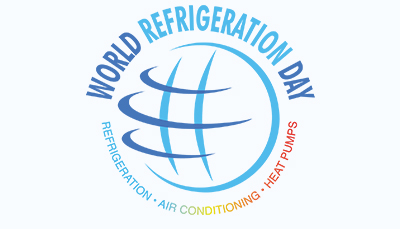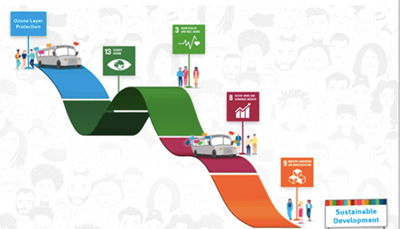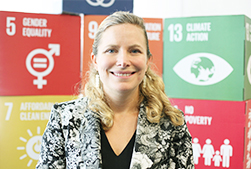WELCOME TO THE SECOND ISSUE OF THE UNIDO MONTREAL PROTOCOL NEWSLETTER!
This issue of our newsletter invites you to learn more about UNIDO’s activities to drive global climate action under the Montreal Protocol. The Kigali Amendment to the Montreal Protocol bridges the gap between ozone layer protection and climate action, evolving to promote climate-friendly alternatives and energy efficiency improvements. This new chapter also represents a key stepping stone to meet the climate targets of the Paris Agreement.
In this issue, we are pleased to share the perspective of our partners and field officers on the implementation of Montreal Protocol projects and the opportunities that arise from cooperation, smart design and technology innovation. Read the feature article “Towards a New and Better Normal” for insights on sustainable cold chain development in the Philippines and our interview with UNIDO’s field office in Uganda on strengthening knowledge and institutions to achieve mutual success in climate action, skills development and sustainable growth. We also invite you to test your knowledge by solving our interactive quizzes.
Once again, we welcome you to reach out to our team and submit your questions via the form at the bottom of the page, which we will gladly answer in the “Ask UNIDO” section of the next issue.
Happy reading!
Your UNIDO Montreal Protocol Division Team
ASK UNIDO
Industrial Development Officer, explains how Montreal Protocol activities contribute to the Paris Agreement.
INTERVIEW
FEATURE ARTICLE
Project Leader for the Global Partnership for improving the Food Cold Chain in the Philippines, writes about the opportunity that the country has to set itself on a path towards sustainable cold chain development through co-operation, smart design and innovative technology.
SUDOKU

Substances
- HFC _ _ _a is a pure substance used in many applications, included in Annex F of Kigali Amendment.
- HFC- _ _ used in industrial refrigeration, stationary air conditions and with a GWP of 675.
- HFC- _ _ is a controlled substance under group II of Annex F of Kigali Amendment.
- GWP of R-507A is (_ 9)( _ _ ); it is used commonly in industrial and commercial refrigeration.
- GWP of HFC-152a is _ _ _, used in foam and aerosol sector.
* GWP values for 100-year time horizon (based on Annex F of the KA)
Relevant years and figures
- 20 _ _, is the year that the Kigali Amendment entered into force.
- High Ambient Temperature (HAT) countries are those with a peak monthly average temperature above _ _ degrees Celsius for an average of at least 2 months per year, over 10 consecutive years.
- Baseline formula for Article-5 countries group 1 in Kigali Amendment is the average of HFC consumption for 2020-2022 plus _ _% of HCFC baseline.

Substances
1. HFC 134a is a pure substance used in many applications, included in Annex F of Kigali Amendment.
2. HFC-32 used in industrial refrigeration, stationary air conditions and with a GWP of 675.
3. HFC-23 is a controlled substance under group II of Annex F of Kigali Amendment.
Global Warming Potential (GWP)
4. GWP of R-507A is (39)(85); it is used commonly in industrial and commercial refrigeration.
5. GWP of HFC-152a is 124, used in foam and aerosol sector.
Relevant years and figures
6. 2019, is the year that the Kigali Amendment entered into force.
7. High Ambient Temperature (HAT) countries are those with a peak monthly average temperature above 35 degrees Celsius for an average of at least 2 months per year, over 10 consecutive years.
8. Baseline formula for Article-5 countries group 1 in Kigali Amendment is the average of HFC consumption for 2020-2022 plus 65% of HCFC baseline.
NOTICE BOARD
Notes
-
Social Media

Join us in celebrating the cooling champions from UNIDO's WRD social media campaign.
Notes
-
Events
Watch the virtual event on the SPODS implementation project in Mexico and challenges in the RAC sector.
Notes
-
Spotlight

Immerse yourself in our stories, photos and videos from UNIDO's recently launched interactive SDG publication.
QUESTION

Global implementation of the Kigali Amendment to the Montreal Protocol could prevent up to 80 billion tonnes CO2 equivalent of emissions by 2050. This would make a significant contribution to the Paris Agreement to reduce climate change.
How well do you know these two agreements?
Select the option (A, B or C) with ALL the correct answers below:
The Paris Agreement was adopted and went into effect in 2015.
The Paris Agreement’s long-term temperature goal is to keep the increase in global average temperature to well below 1.5°C above pre-industrial levels.
The Kigali Amendment was agreed upon in 2016 and entered into force in 2019.
The Kigali Amendment’s long-term phase-down objective is to achieve an 85% HFC phase-down in developing countries by 2036.
The Paris Agreement was adopted in 2015 and went into effect in 2016.
The Paris Agreement’s long-term temperature goal is to keep the increase in global average temperature to well below 2°C above pre-industrial levels; and to pursue efforts to limit the increase to 1.5°C.
The Kigali Amendment was agreed upon in 2016 and entered into force in 2019.
The Kigali Amendment’s long-term phase-down objective is to achieve an 85% HFC phase-down in developed countries by 2036 and an 85% phase-down in all developing countries by 2047.
The Paris Agreement was adopted in 2015 and goes into effect in 2020.
The Paris Agreement’s long-term temperature goal is to keep the increase in global average temperature to well below 4°C above pre-industrial levels; and to pursue efforts to limit the increase to 2°C.
The Kigali Amendment was agreed upon and entered into force in 2016.
The Kigali Amendment’s long-term phase-down objective is to achieve an 85% HFC phase-down in both developed and developing countries by 2036.
Correct! the answer is: B
Wrong, the answer is: B
- The Paris Agreement was opened for signature on 22 April 2016 (Earth Day) and went into effect on 4 November 2016.
- The aim of the Paris Agreement is to: hold the global average temperature well below 2 °C above the pre-industrial level and pursue efforts to limit the temperature increase to 1.5 °C above the pre-industrial levels.
- The Kigali Amendment was agreed upon in 2016 and entered into force in 2019. The Kigali Amendment builds on the historic legacy of the Montreal Protocol agreed in 1987.
- The agreement will see an 85% phase-down in developed countries by 2036, an 80% phase-down by 2045 in most developing countries including China, and the remaining developing countries reaching an 85% phase-down by 2047.
- The Paris Agreement was opened for signature on 22 April 2016 (Earth Day) and went into effect on 4 November 2016
- The aim of the Paris Agreement is to: hold the global average temperature well below 2 °C above the pre-industrial level and pursue efforts to limit the temperature increase to 1.5 °C above the pre-industrial levels.
- The Kigali Amendment was agreed upon in 2016 and entered into force in 2019. The Kigali Amendment builds on the historic legacy of the Montreal Protocol agreed in 1987.
- The agreement will see an 85% phase-down in developed countries by 2036, an 80% phase-down by 2045 in most developing countries including China, and the remaining developing countries reaching an 85% phase-down by 2047.
ASK UNIDO

You Ask, We Answer!
Bettina Schreck, Industrial Development Officer, explains how Montreal Protocol activities contribute to the Paris Agreement.
“The Paris Agreement encourages parties to pursue fast mitigation climatic measures. How do you integrate the Montreal Protocol activities into the nationally determined contributions (NDCs) to achieve fast mitigation measures?”
The Paris Agreement is an ambitious global agreement that aims for all nations to combat climate change and adapt to its effects. The Kigali Amendment to the Montreal Protocol contributes to this goal by abating hydrofluorocarbons (HFCs), which have high global warming potential. The Sustainable Development Goals provide a holistic framework guiding the international development policy and targeting climate change. These three multilateral agreements have complementary agendas to guide the global agenda towards more sustainable development.
To trigger these actions, countries should have policies and strategies that outline specific actions, for example, defining specific measures for the refrigeration sector, and ozone-depleting substance end-users.
A stepwise approach to defining such measures is to first start by identifying the relevant sectors, and for each one, describing which solutions are available to mitigate direct and indirect greenhouse gas emissions. The next step would be to determine which of these solutions are technically feasible and which would need to be adapted to the local conditions. Next, based on the selected technologies, focus on those that are economically viable in each sector, prioritize low, or no-cost actions. After that, recognizing specific actions to guide stakeholders in each sector, for example, adopting technology or modifying their operational schemes or business plans. Finally, adopting policies and programs, which encourage different stakeholders to take actions, or to accelerate action. UNIDO’s technical assistance includes a broad spectrum of support measures, ranging from capacity building and awareness raising, financing, and standards.
To meet the goals of the Kigali Amendment, as well as the ambitious targets of the Paris Agreement, these policies and strategies should be holistic; covering technologies typically utilized for both refrigerants phase-out/phase-down and contemplate energy-efficient production and energy-efficient operations of facilities.
To align the actions identified for the priority sectors, which utilize ozone-depleting substances (ODS), National Ozone Units (NOUs) may choose to work with climate change counterparts and line ministries, to integrate the refrigeration sector actions into the national climate policy instruments. Climate Change policy instruments include the Nationally Determined Contributions (NDCs), which are descriptive documents in which countries communicate their planned contribution to global efforts to reach the global peaking of greenhouse gases (GHGs). NDCs are a requirement of the Paris Agreement (Art. 4) and need to be submitted to the United Nations Framework Convention on Climate Change. Lately, countries have begun developing national cooling action plans and roadmaps, which follow part of the steps described above.
These actions, as a whole, serve to reduce greenhouse gas emissions, which play an important role in global efforts to decarbonize the economy. This ultimate goal is what unites the Kigali Amendment, the NDCs and the Paris Agreement.
INTERVIEW

Interview with Mary Najjuma & Judith Atim
Mary Najjuma, National Energy Efficient Refrigeration Consultant and Judith Atim, Communication & Knowledge Management Consultant on their views and insights in the implementation of Montreal Protocol Division projects and higher learning institutions in Uganda.
In 2016, countries committed to reduce greenhouse gas (GHG) emissions through the Paris Agreement. As parties to the agreement, countries express their commitments to reduce GHGs through nationally determined contributions (NDCs), which are prepared every five years. Which mitigation actions could be undertaken by Uganda to reduce GHGs in the cooling sector as part of their NDCs?
Mary: Considering Uganda’s cooling sector, the servicing sector is way bigger than the manufacturing sector since most of the equipment is imported. Therefore, some of the mitigations actions that Uganda can undertake to reduce GHGs in the cooling sector as part of their NDCs include firstly, capacity building of on-the-job uncertified technicians on how to install maintain and service equipment using climate friendly refrigerants. Further, creating ozone depleting substances (ODS) banks especially in urban areas, which are highly populated. The aim of ODS banks management is to contain the fluorinated gases and ultimately destroy the refrigerants. On top of that, another important point would be to review the existing Minimum Energy Performance Standards (MEPS) to clearly include cooling equipment and ensure monitoring and verification for compliance.
How can projects implemented by UNIDO’s Montreal Protocol Division in cooperation with the National Ozone Office of Uganda support the actions you just recommended?
Mary: Due to the experience and good track record of implementing projects aimed at reducing GHG emissions, UNIDO’s Montreal Protocol Division can support the National Ozone Office of Uganda as an implementing or cooperating agency. With endorsement, from the National Ozone Office, UNIDO can submit proposals for funding to any of the financing avenues.
Which financing avenues are available for developing countries like Uganda if they commit to reducing emissions in the cooling sector?
Mary: Some of the available funding avenues available for developing countries in Uganda include The Multilateral fund (MLF); Kigali Cooling Efficiency Program – NDC facility (K-CEP NDC facility); Nationally Appropriate Mitigation Actions (NAMAs) facility and the Green Climate Fund (GCF).
Judith, how has UNIDO supported institutions of higher learning in the country created by the Government of Uganda?
Judith: These institutions of higher learning are public institutions established by the Government of Uganda to provide learners with hands-on skills in different technical and vocational courses.
UNIDO is providing technical assistance to the Government of Uganda through the National Environment Management Authority (NEMA) to implement the domesticated ozone regulation. Uganda is a signatory to the Vienna Convention on the protection of the Ozone layer and the Montreal Protocol on substances that deplete the Ozone layer, as well as the Kigali amendment. In this regard, UNIDO, through the Hydrochloroflourocarbons Phase-out Management Plan (HPMP), is supporting institutions of higher learning including Kyambogo University, Elgon, Bushenyi, and Ogolai Technical Institutes by providing equipment and skills training for Refrigeration and Air Conditioning technicians in best practices of handling refrigerants and ozone depleting substances. Through this intervention, UNIDO is providing critical support in regards to safeguarding the environment and strengthening knowledge and institutions.
How do these institutions of higher learning affect the country’s economy and environment?
Judith: These institutions provide skills training for hundreds of young Ugandan men and women who enter the job market annually. Existing companies and institutions absorb some, while others go on to establish their own workshops which serve their communities. Whether they are employed by somebody else or whether they choose to create their own employment opportunities, these technicians provide much needed services from which they earn some income which enables them to meet their daily needs and the needs of their families. In addition, the technicians who have been trained in good refrigeration and air conditioning practices are highly skilled and trained on a range of issues related to protecting the ozone layer. They can identify refrigerants, which are harmful to the ozone layer and those which are not. This knowledge enables them to remove harmful refrigerants from old fridges and to replace them with the recommended refrigerants which are ozone friendly and in so doing, they play a tremendous role in safeguarding the environment by ensuring that the refrigerants they use are not ozone depleting.*
Can you give an example of how these higher learning institutes have an impact on the personal life of Ugandans?
Judith: The support UNIDO is rendering to these government-owned or public institutions has had a tremendous impact on the lives of several learners. UNIDO has been providing equipment and practical lessons for both instructors and students undertaking courses in refrigeration and air-conditioning. This has been very helpful in complementing government efforts in providing skills training to thousands of Ugandans. Previously, vocational and technical education was predominantly taken to be a field for men. Overtime we are witnessing more women taking up interest in these courses and thereby debunking the myth that only men have the aptitude for science and engineering courses. However, female enrolment in these courses remains quite low compared to male students’ enrolment. Nonetheless, the few females who enroll for these courses have a lot of enthusiasm. In 2019, UNIDO conducted a number of trainings on best practices in refrigeration and air conditioning. One of the institutes that benefited is Ogolai Technical Institute in Amuria district, in eastern Uganda. Here we met Martha Asekenye who is one of the female students at the institute. She spoke to UNIDO about her interest in the course and her dreams for the future:
“I chose this course because my uncle is a technician/engineer. He is benefiting a lot from his skills. I have always wanted to be an engineer since childhood. I want to be an important person like my uncle and hopefully become a professor one day and be well known like him. Many girls fear to study technical courses like these because they have a perception that it is difficult and that only boys or men can study such. I love this course and I have gained a lot of skills. During my industrial training, I met many people who gave me a lot of encouragement. I was able to open the indoor and outdoor unit of the air conditioning alone. Like my classmates have said, we do not have enough time and resources to have many practical lessons. We would really like to do more in this area. The training UNIDO gave us this week has taught me so much. Now I know how to charge, vacuum, collect data. I have also known how to use many tools which I was not able to use earlier. I wish that UNIDO could make the trainings longer than a week. We need at least a month because there are so many things to learn.’’
Again, at a personal level, the support UNIDO provides to these institutions helps in building the capacity of individuals and many of them look forward to establishing their own workshops from where they can earn a decent living.
* The aim of the Kigali Amendment to the Montreal Protocol is to phase-down hydrofluorocarbons (HFCs) by cutting their production and consumption. HFCs are commonly used as alternatives to HCFCs as they do not destroy the ozone layer, but they still have a high Global Warming Potential (GWP). UNIDO encourages Parties to the Montreal Protocol to avoid the use of these HFCs as transitional substances and instead shift towards long-term low-GWP solutions.
FEATURED ARTICLE

Towards a New and Better Normal
Gilda Garibay, Project Leader for the Global Partnership for improving the Food Cold Chain in the Philippines, writes about the opportunity that the country has to set itself on a path towards sustainable cold chain development through co-operation, smart design and innovative technology.
COVID-19 has exposed the fragility of the Philippines’ agriculture value chains. In March and April, at the height of the enhanced community quarantine, rural farmers were not able to sell their produce which led to a lot of food wastage. Cold storage plays a crucial role in avoiding post-harvest losses in agriculture, and in ensuring the country’s food security. Aside from its economic role, the cold storage industry also plays a key role in reducing harmful greenhouse gases from being released into the atmosphere. The on-going pandemic gives an opportunity for the government and business sector to shift towards more sustainable ways of strengthening agriculture value chains and ensuring food security.
Due to its multi-level stakeholders, multi-sectoral, and multi-technology nature, the cold storage industry has the potential to transform the food supply chain into a direction which is more sustainable. This entails the shift to “clean” cooling systems which not only means using natural refrigerants but also efficient energy use.
Business-as-usual no longer an option
With the impact of climate change, business-as-usual is no longer an option. Environmentally sound business operations may entail significant initial investments but the opportunities and benefits outweigh the costs. Savings that will be incurred with cleaner cooling systems will protect businesses from rising electricity prices. Moreover, it will address consumer demand for more ecologically friendly products and regulatory compliance — particularly on ‘greening’ buildings and business operations.
Clean cooling can be a holistic approach. Green strategies can also be applied in the design and operation of whole cold storage facilities, not just on the refrigeration system alone. According to a study conducted in the United States in 2016, 54% of energy used in cold storage facilities is for refrigeration, while the rest is for other purposes such as office HVAC, lighting and other facility equipment. There is a need to manage effectively the 46% energy usage if monetary savings and responsible environmental operation is to be achieved.
Smart design techniques to reduce cooling demand and energy use
Green building is the direction now. This prompted the government to develop the Green Building Code, which set guidelines on the design of buildings and its impact on energy and water use, as well as solid waste management. In parallel to this effort, several accreditation bodies have been established to validate ‘green’ building practices. The main goal is to make the facility use less energy and water while maintaining its purpose and convenience. Below are some of the measures that cold storage facilities can explore towards sustainable operation.
In terms of building design of cold storage facilities, the following can be considered:
- Orientation of the building to minimize exposure to the sun’s path, meaning the building’s short side should face the east-west axis;
- The use of light colored roofing as black roofs absorb more heat resulting in an 80°C warmer roof compared to white roofs. This further results in an inside temperature 30°C warmer than buildings with white roofs;
- Allowing air inlet and air outlet in the roofing in order to have a constant supply of fresh air to cool the area between the roof and the ceiling (attic). Well ventilated attics are up to 40% cooler, resulting in a minimization of interior heating;
- Decreasing the transfer of undesirable solar heat by means of window films and planting trees and plants around the building;
- Maximizing natural day lighting with the use of skylight roofing or solar tubes and the installation of big windows. Daylighting can cut lighting energy use by up to 80%;
- Preventing heat islands that radiate high temperatures to the surrounding area and buildings, thus instead of concrete pavement, using permeable or natural pavement.
For energy management, the following should be taken into account:
- Peak load management or maximizing energy usage during off-peak hours when electricity is cheapest;
- Avoiding standby loss by unplugging appliances that are not in use;
- Avoiding unnecessary power consumption. One way to do this is through the labelling of switches;
- Using energy efficient lighting and appropriate wattage for a room or purpose;
- Ensuring an air-sealed air-conditioned room and keeping the energy efficient unit in good working condition by safeguarding it from the source of heat;
- Considering investing in renewable energy such as solar power.
Like energy, water is a precious resource and responsible use of it saves a lot of money. There are many ways to save water like through re-use and recycling, the use of water-efficient plumbing fixtures, the installation of sub-meters, conducting water audits, implementing a water management plan, among others. The installation of a rain water collection system is also a good investment. And on-site water treatment for re-use can also be used as an environmental indicator.
The COVID-19 pandemic may pose a lot of challenges, but it has also enabled society to re-think the “business-as-usual” approach and focus on what is more important. People are now more conscious in terms of consumption, as they focus on products and services deemed essential and sustainable. With this, the demand for “clean” cooling systems and “green” buildings are expected to rise. It is now high time for the government and business sector to work together towards making it part of the “new and better normal”.
CONTACT US
Subscribe to our newsletter
Sign up to receive a quarterly email with updates and new content!
Disclaimer
The information presented in this newsletter does not necessarily reflect the views of UNIDO. Links to external websites are included solely to provide additional information and do not imply any official endorsement of the opinions, ideas, data, or products presented.
© 2020 UNIDO Montreal Protocol
